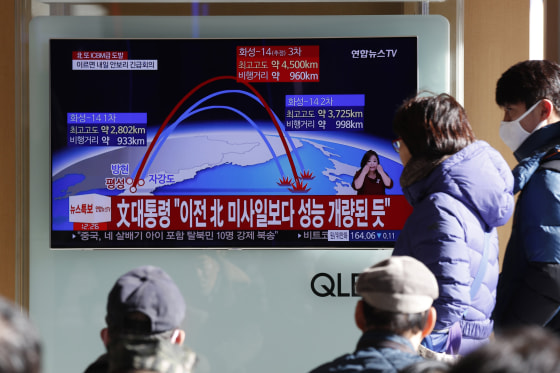Kim Jong Un's latest ballistic missile test flew 10 times higher than the International Space Station and twice as high as any satellite in low-earth orbit, according to South Korea's military.
Although analysts were scrambling Wednesday to learn what they could about the North Korean launch, Pyongyang said it had tested a new type of missile, named the Hwasong-15.
Dictator Kim's secretive state claimed it was carrying a "super-large heavy warhead" that was capable of striking the entire U.S. mainland. But analysts say that based on the current evidence it's hard to prove or debunk the North's claim that it can now hit faraway American targets such as New York or Washington, D.C.
The North Koreans have now test-fired missiles 18 times since President Donald Trump took office in January. Tuesday's launch was the first in more than two months.
Western officials agreed it appeared to be an intercontinental ballistic missile, or ICBM, which flew further than any other demonstrated by the North.
It was fired on what is called a "lofted" trajectory, meaning it was aimed at a steep angle and traveled very high but landed relatively close to its launch site.
Reaching an altitude of around 2,800 miles above the Earth's surface, according to South Korea, it crashed down in the Sea of Japan around 600 miles away from where it was fired.
"It went higher, frankly, than any previous shot they've taken," Defense Secretary James Mattis told reporters at the White House.
Some experts believe that if North Korea aimed the rocket at a lower angle, as it would in an attack scenario, this range could be stretched to some 8,100 miles — theoretically putting the entire East Coast in range.
"If we extrapolate this test we think it would give North Korea the capability to reach Washington, D.C.," according to John Nilsson-Wright, a senior research fellow at London's Chatham House think tank.
However, to build a weapon capable of hitting the U.S. a long-range rocket is just one piece of the puzzle.
North Korea would also need to develop a reentry vehicle robust enough to protect the warhead from the intense heat produced by traveling through the Earth's atmosphere at speed. It also needs to miniaturize a nuclear weapon small and light enough to fit on the missile without reducing its range.
Boasts aside, it hasn't publicly demonstrated either of these.
"North Korea is not suicidal and this does not look like a first-strike weapon"
"We still don't know the ability of North Korea to put a warhead on a long-range missile and fire it with accuracy," Nilsson-Wright said.
The North said the missile tested Tuesday was tipped with a "super-large heavy warhead" but analysts said there's no way to know for sure.
"We just don't know what was on the front end of this thing," said Tom Plant, director of the Proliferation and Nuclear Policy program at the Royal United Services Institute, another London-based think tank.
According to a statement from Michael Elleman, a ballistic missile analyst at the Johns Hopkins School for Advanced International Studies, "a viable ICBM capable of reaching the West Coast of the U.S. mainland is still a year away, though North Korea continues to progress."
South Korea responded to the launch, which came in the early hours of Wednesday morning local time, by firing three missiles of its own, which were designed to show it could strike North Korea's launch sites.
Presidential spokesperson Park Soo Hyu described these counter-launches as "a show of force."
All of North Korea's missile tests violate United Nations sanctions. Following the latest launch, the foreign ministry of China, which Trump has been pressing to do more to squeeze its neighbor, said it expressed "deep concern and opposition to launch activities."
Whatever North Korea's current capability, Tuesday's launch should come as no surprise to the international community. The country has repeatedly stated its aim of building a nuclear weapon capable of hitting the U.S.
But most analysts say that even if it achieved that goal it would likely not want to start using these weapons unless it was attacked first. Rather, according to many experts, it wants to acquire nukes as a deterrent against the U.S. trying to topple Kim's regime.
"North Korea is just marching toward where it's headed. There's no sign it will stop before it gets there," Plant said. "But North Korea is not suicidal and this does not look like a first-strike weapon."
North Korea has said in public statements that it wants an official end to the Korean War. The conflict was halted by a 1953 armistice but no peace treaty has been signed. It also wants nothing short of full normalization of relations with the U.S. and to be treated with respect and as an equal in the global arena.

